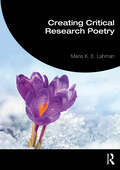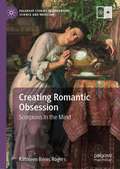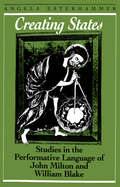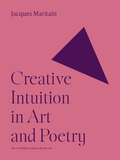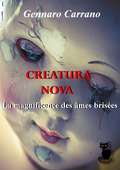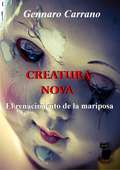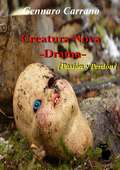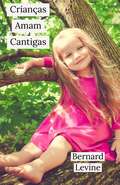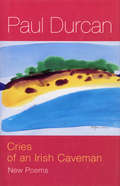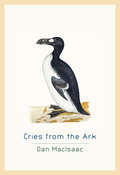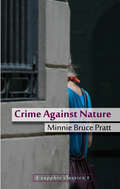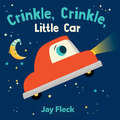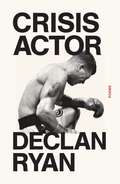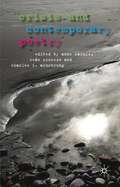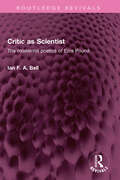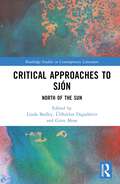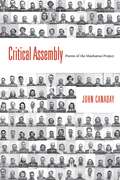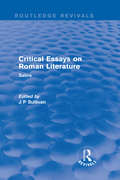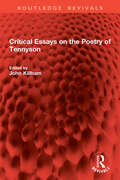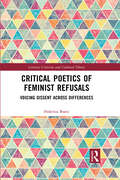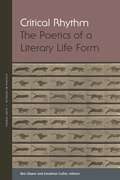- Table View
- List View
Creating Critical Research Poetry
by Maria K. LahmanCreating Critical Research Poetry critically engages with the ways in which researchers can poetically approach textual representations that narrate the unnarratable and contest the uncontested.This text provides a rich path for early research poets to engage with and bloom and established research poets to dig deeper and flourish.Connections to literary poetry and critical social science theories are detailed. First-person poetic accounts where poets describe early fruitful engagement with poetic forms are highlighted. Free verse, formed poetry, and dimensional poems (e.g. concrete poetry) are covered in depth, with guidance for developing a poetic sensibility and honing research poetry craft. Poetic experiences are integrated throughout the book, which may be engaged with individually, as a group, and in virtual or face-to-face courses.Each chapter provides reflexive questions for the reader to engage with in their own journal writings, a poem creation exercise, and further poetic resources. Set within critical theories, Creating Critical Research Poetry provides a context for early research poets, and thought-provoking possibilities for seasoned research poets. This is the perfect entry point to this burgeoning field of critical inquiry and qualitative research.
Creating Romantic Obsession: Scorpions in the Mind (Palgrave Studies in Literature, Science and Medicine)
by Kathleen Béres RogersMost of us have, at one time, been obsessed with something, but how did obsession become a mental illness? This book examines literary, medical, and philosophical texts to argue that what we call obsession became a disease in the Romantic era and reflects the era’s anxieties. Using a number of literary texts, some well-known (like Mary Shelley’s 1818 Frankenstein and Edgar Allan Poe’s 1843 “The Tell Tale Heart”) and some not (like Charlotte Dacre’s 1811 The Passions and Charles Brockden Brown’s 1787 Edgar Huntly), the book looks at “vigilia”, an overly intense curiosity, “intellectual monomania”, an obsession with study, “nymphomania” and “erotomania”, gendered forms of desire, “revolutiana”, an obsession with sublime violence and military service, and “ideality,” an obsession with an idea. The coda argues that traces of these Romantic constructs can be seen in popular accounts of obsession today.
Creating States: Studies in the Performative Language of John Milton and William Blake
by Angela EsterhammerAlthough the concept of the performative has influenced literary theory in numerous ways, this book represents one of the first full-length studies of performative language in literary texts. Creating States examines the visionary poetry of John Milton and William Blake, using a critical approach based on principles of speech-act theory as articulated by J.L. Austin, John Searle, and Emile Benveniste. Angela Esterhammer proposes a new way of understanding the relationship between these two poets, while at the same time evaluating the role of speech-act philosophy in the reading of visionary poetry and Romantic literature. Esterhammer distinguishes between the 'sociopolitical performative,' the speech act which is defined by a societal context and derives power from institutional authority, and the `phenomenological performative,' language which is invested with the power to posit or create because of the individual will and consciousness of the speaker. Analysing texts such as The Reason of Church-Government, Paradise Lost, The Marriage of Heaven and Hell, and Jerusalem, Esterhammer traces the parallel evolution of Milton and Blake from writers of political and anti-prelatical tracts to poets who, having failed in their attempts to alter historical circumstances through a direct address to their contemporaries, reaffirm their faith in individual visionary consciousness and the creative word – while continuing to use the forms of a socially or politically performative language.
Creative Intuition in Art and Poetry (The A. W. Mellon Lectures in the Fine Arts #1)
by Jacques MaritainThe classic work on the sublime interplay between the arts and poeticsThis book explores the rich and complex relationship between art and poetry, shedding invaluable light on what makes each art form unique yet wholly interdependent. Jacques Maritain insists on the part played by the intellect as well as the imagination, showing how poetry has its source in the preconceptual activity of the rational mind. As Maritain argues, intellect is not merely logical and conceptual reason. Rather, it carries on an exceedingly more profound and obscure life, one that is revealed to us as we seek to penetrate the hidden recesses of poetic and artistic activity. Incisive and authoritative, this illuminating book is the product of a lifelong reflection on the meaning of artistic expression in all its varied forms.
Creatura Nova
by Gennaro CarranoA Imolada, A Gentil, Sensibilidade, Delicado, Eros, Pálida. Uma jornada poética para descobrir as várias facetas da alma humana, onde o bem é confundido com o mal, o amor se funde com ódio, o perdão se torna culpa. Qual o limite entre o certo e o errado? A consciência será realmente um juiz imparcial? Será a moralidade apenas um condicionamento social? Uma eterna luta entre o instinto e a razão... A Creatura Nova pretende, através do estilo e da temática, representar uma nova maneira de fazer poesia. Um estilo antigo que se fundiu com temas atuais e métodos modernos. Mais do qu com uma antologia, deparamo-nos com uma narrativa poética real. Pela primeira vez, um tema difícil, como o estupro incestuoso, é tratado na poesia. As principais temáticas são as facetas da alma humana, vistas sob vários pontos de vista. E 'dividido em 'capítulos': "A Imolada" e "A Gentil" são o âmago da narrativa poética, onde é narrada a história de Adelfo (do grego = adelphos irmão) que estupra a irmã Verginia. Esta vai encontrar forças para perdoá-lo mas também o perdão se pode tornar uma grande culpa, e serão essa, de fato, que elouquecerá o protagonista Adelfo. Outra peculiaridade são os narradores. Em "A Imolada", os dois primeiros poemas são narradas por um narrador externo e os dois últimos do ponto de vista interno, ou seja, o de Adelfo. A mesma coisa acontece no capítulo "A Gentil", onde nos dois primeiros poemas o narrador é externo e nos dois últimos é interno, isto é, temos o ponto de vista da irmã Verginia. Isso possibilita olhar para a história, para o carrasco e a vítima de diferrentes perpectivas. No momento em que os seus papéis se misturam, a vítima torna-se carrasco e o carrasco, vítima. Nos oito poemas está presente um elemento commum: o lírio, um símbolo de pureza. Os restantes, sempre divididas por tema, tratam de temas como o amor a Deus, erotismo, autoflagelação, feminicídio e abandono.
Creatura Nova La magnificence des âmes brisées
by Sonia Broyart Gennaro CarranoL'Immolata, la Gentile, Sensibilitade, Delicato, L'Eros, Pallida. Un voyage poétique à la recherche des différentes facettes de l'âme humaine où le bien et le mal, l'amour et la haine se confondent, où le pardon devient culpabilité. Où se trouve la frontière entre ce qui est juste et ce qui ne l'est pas ? La conscience est-elle réellement un jugement impartial ? La morale est-elle seulement un conditionnement de la société ? Une lutte éternelle entre instinct et raison... " Con Rassegnatio Et Assolutio Tollereresti Un Riprovevole Atto?" " Nell'Odiar Vivrei Angustiato!"
Creatura Nova - El Renacimiento de la Mariposa
by Roberto Carlos Pavón Carreón Gennaro CarranoLa Inmolada, la Gentil, Sensibilidad, Delicado, El Eros, Pálida. Un viaje poético al descubrimiento de las diversas facetas del alma humana, donde el bien se confunde con el mal, le amor se funde con el odio, el perdón se vuelve una culpa ¿Cuál es la frontera entre lo que es justo y lo que es incorrecto? ¿La conciencia es en verdad un juez imparcial? ¿La moral es únicamente un condicionamiento social? Una eterna lucha entre instinto y razón... " Con Rassegnatio Et Assolutio Tollereresti Un Riprovevole Atto?" " Nell'Odiar Vivrei Angustiato!" Criatura Nueva quiere por estilo y temática representar un modo nuevo de hacer poesía. Un estilo antiguo fusionado con temáticas actuales y modalidad modernas. Nos enfrentamos, de hecho, más que a una compilación a una verdadera y propia narrativa poética. Por primera vez viene afrontado en poesía un tema escabroso como el estupro incestuoso. Las temáticas principales son las facetas del alma humana, vistos bajo varios puntos de vista. Está subdividido en "capítulos": La Inmolada y la Gentil son el verdadero y propio fulcro de la narración poética, de donde viene la historia de Adelfo (del griego adelphos = hermano) que viola a la hermana Virginia, ella encontrará la fuerza para perdonarlo aunque el perdón también puede ser una gran culpa, será esto, de hecho, lo que hará enloquecer al protagonista Adelfo. Otra particularidad son los narradores en la Inmolada tenemos las primeras dos poesías narradas por un narrador externo y las últimas 2 desde el punto de vista interno, es decir el de Adelfo. Lo mismo sucede en los capítulos de "La Gentil", donde en las primeras 2 poesías, el narrador es externo y en las últimas dos es interno, o sea tenemos el punto de vista de la hermana Virginia. Es un modo para ver con varios ojos y bajo varios aspectos, la historia, el carnicero y víctima, a medida que estos papeles se mezclan, la
Creatura Nova: Pasión y perdón
by Gennaro CarranoAtemporal drama en el que autor Gennaro Carrano nos muestra los polos opuestos del ser humano: la extrema maldad y la bondad absoluta y cuyo final soprenderá al lector por la crudeza de los hechos. La historia proviene de una época lejana y de un lugar que bien podría estar más cercano de lo que imaginamos. Dos hombres nos la traen, tan distantes entre sí como el tiempo y el lugar del mismo. Felice, poeta de la alta sociedad y Valerio, un hombre sencillo. El impulso de contarla surge de un sentimiento vacilante, el deseo de comunicar la deriva de sentimientos ignorados y el impulso de deshacerse de una pesada carga. Dos hermanos son los protagonistas de la historia: Verginia y Adelfo. La miseria, la soledad, la ignorancia, la ira y la frustración pueden ser una mezcla explosiva para cualquier hombre que no esté acostumbrado a verse por dentro.
Crianças Amam Cantigas
by Bernard LevineAqui está uma coleção de melhores cantigas de ninar para você ler para suas crianças. Todas essas preciosas e amadas cantigas foram passadas de geração em geração, de mãe para filha e de pai para filho por eras. Os pequeninos vão amar e se divertir aprendendo e recitando essas rimas eternas. Este é um livro que crianças vão adorar e reler várias e várias vezes.
Cries Of An Irish Caveman
by Paul DurcanCries of an Irish Caveman is Paul Durcan's most inspired and surprising collection of poems. Through four distinct sections, he brings his tender lyricism to bear on the themes of love, loss, life and death.The first section describes an experience in Australia which provides a starting point for reassessing his past relationships and loves. The second returns to Ireland, its people and places, the celebrated and the unknown. The third section is a meditation on his daughter's marriage, placing within an historical and sacramental context a very personal event. And finally, in some of his most daring and original writing, Durcan describes his own twentieth-century romance, replete with ecstasies and inevitable agonies, beauty and hope, but also brutality and self-abasement.
Cries from the Ark
by Dan MacIsaacA pitch-perfect debut and a call to act in the service of Earth through radiant attention. Humankind, at present, has breached floodgates that have only been breached before in ancient stories of angry gods, or so far back on geologic and biological timelines as to seem more past than past. Against this catastrophic backdrop (at the end of consolations, at the high-water mark), and equipped with a periscopic eye and a sublime metaphorical reach, poet Dan MacIsaac has crowded his debut vessel with sloths and auks, mummified remains and bumbling explorers, German expressionists and Neolithic cave-painters. With the predominant “I” of so many poetic debuts almost entirely absent, Cries from the Ark is catalogue and cartography of our common mortal—and moral—lot.
Crime Against Nature
by Minnie Bruce PrattPoetry. LGBT Studies. The first title from Sapphic Classics, a co-edition between Sinister Wisdom Magazine and A Midsummer Night's Press to reprint seminal works of lesbian poetry.
Crime Against Nature (Sapphic Classic)
by Minnie Bruce PrattMinnie Bruce Pratt's Crime Against Nature was the 1989 Lamont Poetry Selection from the Academy of American Poets, which recognizes a poet's second collection of poetry. Crime Against Nature has been long out of print, until now. This new edition includes an introduction by Julie R. Enszer, a new afterword by Pratt, a reprint of Pratt's speech at the Lamont award ceremony, photographs of Pratt and her family, and a bibliography.
Crinkle, Crinkle, Little Car
by Jay FleckSing along with this bedtime favorite set to the tune of Twinkle, Twinkle, Little Star!A noisy little car zooms through the night sky, waking the stars and moon. Will this mischievous traveler ever quiet down for bedtime? This playful twist on a classic nursery song is a goodnight favorite that's sure to soothe even the most wide-awake little ones to a peaceful—and quiet!—bedtime.BEDTIME SING-ALONG: This familiar, soothing song with a funny twist makes for a great read-aloud or sing-along at bedtime and beyond.SETTLE INTO SLEEP: With a gentle goodnight ending that shows that even the noisiest little car is eventually ready to rest, this book will soothe reluctant sleepers at bedtime.CELEBRATED AUTHOR: Jay Fleck, the illustrator of the Tiny T. Rex series, has created another irresistible character that families are sure to fall in love with!Perfect for:• Parents and family friends• Gift-givers• Parents of infants and toddlers• Parents of children interested in cars• Fans of sing-along books• Anyone looking for a sweet and simple bedtime story
Crisis Actor: Poems
by Declan RyanThe brilliant and bracing debut collection of poetry from Declan Ryan: a writer, critic, and fierce new literary voice.Declan Ryan's Crisis Actor chronicles various kinds of failures and farewells. It is peopled by faded heroes and deferential devotees, a hanged donkey and a bloated rat, solitary bachelors and disillusioned youths—these are the watchers, not the players. The poems are awash in rueful self-accusation and laconic skepticism. There are touching elegies, reportage, and bruised, wary replayings. A blistering sequence about boxers and their fates weaves through the collection. The overwhelming sense is of life going on elsewhere, the halcyon days and brightness of years long past. This is the aftermath of being one who—in Matthew Arnold’s words—"has reached his utmost limits and finds . . . himself far less than he had imagined himself."But there are still flashes of camaraderie, of stars aligning: lunchtimes in sunlit garden squares, languorous afternoons in pubs cheering for hard-won triumphs. These precious, precarious moments point to how we might reclaim potential, discover human connection in times of defeat or despair, and reach toward grace and redemption.
Crisis and Contemporary Poetry
by Anne Karhio Seán Crosson Charles I. ArmstrongWhat are the means available to poetry to address crisis and how can both poets and critics meet the conflicts and challenges they face? This collection of essays addresses poetic and critical responses to the various crises encountered by contemporary writers and our society, from the Holocaust to the ecological crisis.
Critic as Scientist: The modernist poetics of Ezra Pound (Routledge Revivals)
by Ian F. BellFirst published in 1981, Critic as Scientist provides a detailed and scholarly account both of the scientific background and of contemporary artistic issues in its analysis of Ezra Pound’s poetics. During the crucial period of his years in London, Ezra Pound was striving to formulate not only a new system of poetics but also a new language through which he could both define the critic’s procedure and announce his modernity. It was in science that Pound discovered the vocabulary that became his most characteristic gesture during the literary crises of the time. The use of scientific terminology in his ‘propaganda’ for a new ‘renaissance’ belonged, initially, to specifically American modes of aesthetic tradition, as typified by Whistler and aspects of New England transcendentalism. A consideration of popular versions of physics and biology, and of the ‘scientific attitude’ displayed by such contemporaries as Fenollosa, Hulme, Ford and Eliot, reveals that the major terms and practices of Pound’s critical vocabulary were located in the issues of nineteenth and early twentieth-century science. The author has sought to demystify key words in the Poundian vocabulary and has suggested a wider literary and cultural context for the study of Pound’s aesthetic theory. This book will be of interest to students of literature.
Critical Approaches to Sjón: North of the Sun (Routledge Studies in Contemporary Literature)
by Linda Badley Úlfhildur Dagsdóttir Gitte MoseCritical Approaches to Sjón: North of the Sun is the first English-language book-length study of the works of the Icelandic contemporary poet Sjón (Sigurjón Birgir Sigurðsson, b. 1962), who is considered by some to be Iceland’s most distinctive and multifaceted contemporary author. This collection of essays introduces readers to Sjón’s rich body of writing and its transmedial and stylistic range, cultural breadth, thematic diversity, and intellectual depth. Essays in the volume have been brought together from around the world and cover Sjóns's beginnings as a neo-surrealist performance artist and poet (translated into over 20 languages), his career as a novelist (translated into over 30 languages), and his collaborations with translators, singer-songwriters, film directors, and other writers. Approaches range from the narratological, historical, ethical, epistemological, and mythological to theoretical methodologies such as thing theory, queer theory, disability studies, and ecocriticism.
Critical Assembly: Poems of the Manhattan Project (Mary Burritt Christiansen Poetry Series)
by John CanadayWith technical mastery and remarkable empathy, Canaday introduces readers to the people involved in the creation and testing of the first atomic bomb, from initial theoretical conversations to the secretive work at Los Alamos. Critical Assembly also includes brief biographies, notes, and a bibliography for further exploration about this critical event in world history.
Critical Essays on Roman Literature: Elegy and Lyric (Routledge Revivals: Critical Essays on Roman Literature #1)
by J P SullivanFirst published in 1962, this book is the first of two volumes which bridge the gap between the study of classics and the study of literature and attempt to reconcile the two disciplines. Focusing on elegy and lyric, this collection of essays offers a critical examination of Latin literature and aims to stimulate critical discussion of a selection of Latin poets. This experimental and ground-breaking book will be of particular interest to students of Roman Literature, Classics and Poetry.
Critical Essays on Roman Literature: Satire (Routledge Revivals: Critical Essays on Roman Literature #2)
by J P SullivanFirst published in 1963, this book is the second of two volumes which bridge the gap between the study of classics and the study of literature and attempt to reconcile the two disciplines. Focusing on satire, this collection of essays offers a critical examination of Latin literature and aims to stimulate critical discussion of a selection of Latin poets. This experimental and ground-breaking book will be of particular interest to students of Roman Literature, Classics and Poetry.
Critical Essays on William Wordsworth
by George H. GiltinOne of a series called Critical Essays on English Literature.
Critical Essays on the Poetry of Tennyson (Routledge Revivals)
by John KillhamFirst Published in 1960, Critical Essays on the Poetry of Tennyson presents a collection of essays, most of which have been previously published in periodicals and written by renowned critics of Tennyson’s work. The books discusses important themes like Tennyson in temporal contexts; Tennyson in artistic contexts; a study of the Hesperides; study of Demeter and Persephone; Tennyson’s 'Ulysses'; Tennyson’s Maud and Tennyson’s Idylls. This is a must read for scholars of English poetry and English literature.
Critical Poetics of Feminist Refusals: Voicing Dissent Across Differences (Literary Criticism and Cultural Theory)
by Federica BuetiCritical Poetics of Feminist Refusals renders a vivid portrait of the intergenerational and intersectional dialogue between influential feminist writers on how to say no to the conditions of oppression, exclusion, and exploitation imposed by patriarchal and systemically racist capitalist societies. The book provides today’s readers and writers access to the powerful inventory of concepts and techniques that two generations of feminists have assembled for refusing domination and constituting fugitive forms of sociability and writing. Drawing on examples from feminist thinkers, Audre Lorde, Carla Lonzi, Hélène Cixous, Hortense Spillers, Alexis Pauline Gumbs, Anne Boyer and Simone White, the book focuses on how the power dynamics of recognition tie the uses of language to the material conditions of discrimination in everyday life.
Critical Rhythm: The Poetics of a Literary Life Form (Verbal Arts: Studies in Poetics)
by Ben Glaser and Jonathan CullerThis book shows how rhythm constitutes an untapped resource for understanding poetry. Intervening in recent debates over formalism, historicism, and poetics, the authors show how rhythm is at once a defamiliarizing aesthetic force and an unstable concept. Distinct from the related terms to which it’s often assimilated—scansion, prosody, meter—rhythm makes legible a range of ways poetry affects us that cannot be parsed through the traditional resources of poetic theory.Rhythm has rich but also problematic roots in still-lingering nineteenth-century notions of primitive, oral, communal, and sometimes racialized poetics. But there are reasons to understand and even embrace its seductions, including its resistance to lyrical voice and even identity. Through exploration of rhythm’s genealogies and present critical debates, the essays consistently warn against taking rhythm to be a given form offering ready-made resources for interpretation. Pressing beyond poetry handbooks’ isolated descriptions of technique or inductive declarations of what rhythm “is,” the essays ask what it means to think rhythm.Rhythm, the contributors show, happens relative to the body, on the one hand, and to language, on the other—two categories that are distinct from the literary, the mode through which poetics has tended to be analyzed. Beyond articulating what rhythm does to poetry, the contributors undertake a genealogical and theoretical analysis of how rhythm as a human experience has come to be articulated through poetry and poetics. The resulting work helps us better understand poetry both on its own terms and in its continuities with other experiences and other arts.Contributors: Derek Attridge, Tom Cable, Jonathan Culler, Natalie Gerber, Ben Glaser, Virginia Jackson, Simon Jarvis, Ewan Jones, Erin Kappeler, Meredith Martin, David Nowell Smith, Yopie Prins, Haun Saussy
